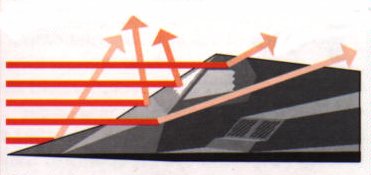|
[About Us] [Links] [Site Map] [Contact & Feedback] |
|
|
||||||
NEWS
 Military
Military Space
Space Above Top Secret
Above Top Secret Pic Of The Week Archive
Pic Of The Week Archive
 HOME HOME
|
[Search] |
Stealth Technology |
||||
 In the late '50s U2 spy planes flew at 80,000ft (24,000m) to be out of range of anti-aircraft fire, but it then became clear that radar was not detecting them. The success of the U-2s led to highly classified research work in the US, known as 'Stealth', to create a military aircraft that was invisible to radar. The U-2 had gone undetected for quite a long time, because it was made of non-metallic materials which absorbed radar waves rather than reflecting them back to the radar ground station, as normally happens. The revolution in radar stealth came in the 1970s when computers were powerful enough to solve the Maxwell electromagnetic equations for reasonably complicated shapes. These equations determine how radar waves are reflected and scattered, and by developing a program capable of predicting the RCS of an entire aircraft from different angles, designers were able to drastically reduce the RCS. The major limitation of this early program was that it could only analyze flat panels, so the F-117 and its Have Blue prototypes were composed of a number of faceted panels. The F-117A Nighthawk Stealth Fighter attack aircraft was developed by Lockheed Martin after years and years of work on stealth technology, and the predecessor test demonstrator aircraft, Have Blue, was carried out in secret from 1975. Development of the F-117A began in 1978 and it was first flown in 1981, but it was not until 1988 that its existence was publicly announced. The Nighthawk is the world's first operational stealth aircraft. From 1978 to 1985, the Northrop Grumman corperation were also developing a stealth demonstrator. This aircraft became known as the "Tacit Blue". This program provided valuable engineering data that aided in the B-2 "Spirit" design. The Tacit Blue was the first aircraft to demonstrate a low radar cross section using curved surfaces. But how does it work?The way most airplane identification works is by constantly bombarding airspace with a RADAR signal. When a plane flies into the path of the RADAR, a signal bounces back to a sensor that determines size, and location of the plane. 

The latest aircraft with stealth technology are the F-22 Raptor, F-35 Joint Strike Fighter and the Eurofighter Typhoon. Stealth at sea??No, this is not for James Bond, this is for the US Navy!
The ship design will also likely include radical composite construction materials, some radar absorbing materials and optimized hull shaping both above and below the waterline. Extensive attention will also be given to acoustic quieting and degaussing for both equipment and propulsion systems. The integrated power system (IPS) is expected to provide substantial quieting capability. The DD-21 Zumwalt-class will be armed with 5-inch/62 extended range guided munitions and 155mm Howitzers, the ship will provide naval gunfire support up to 100 miles inland.
Another stealth boat is the Swedish "Visby Class corvette". The hull is designed on stealth principles with large flat angled surfaces. Every feature that need not necessarily be located outside the hull has been built in or concealed under specially designed hatches. The gas turbine exhausts have been concealed in hidden outlets close to the water surface at the stern of the vessel.  The Visby is equipped with a combined diesel or gas (CODOG) turbine arrangement for high speeds and two diesel engines for low-speed. The engines are connected to two gearboxes, driving two waterjet propulsors. The engines provide a maximum speed of 15 knots for long duration and 35 knots for short duration. The ship has bowthrusters for harbour manoeuvring. 
|
||||
|
|
| Air-Attack.com - All About Military Aviation, Space Projects & News |
|
 |
|
All content © 2001, 2002, 2003, 2004 Air-Attack.com (unless otherwise indicated), all rights reserved. |
||